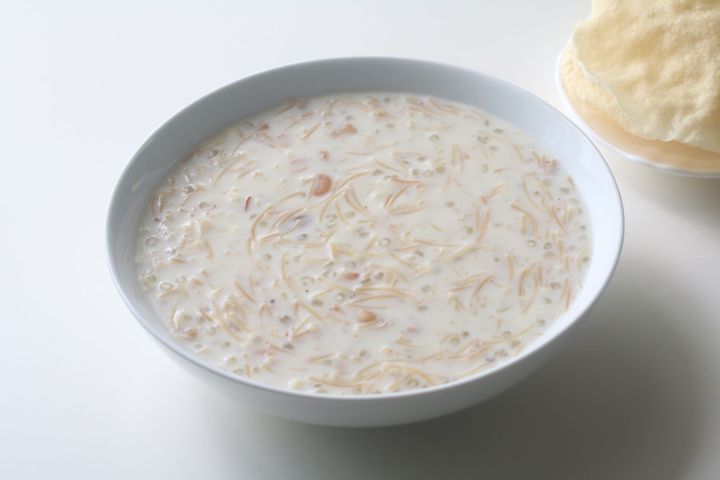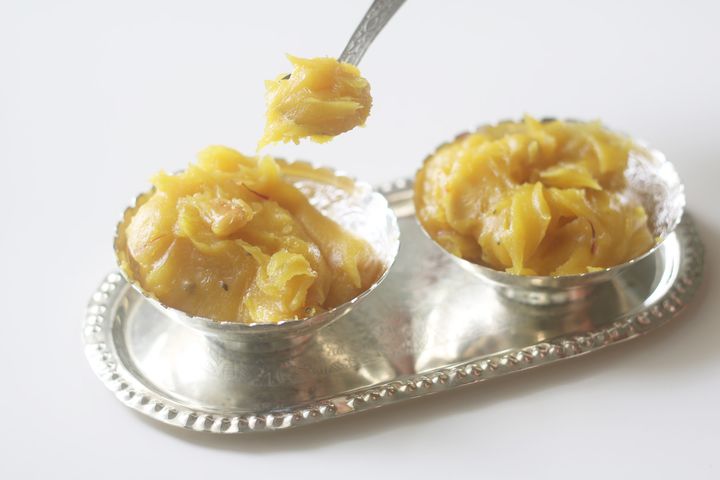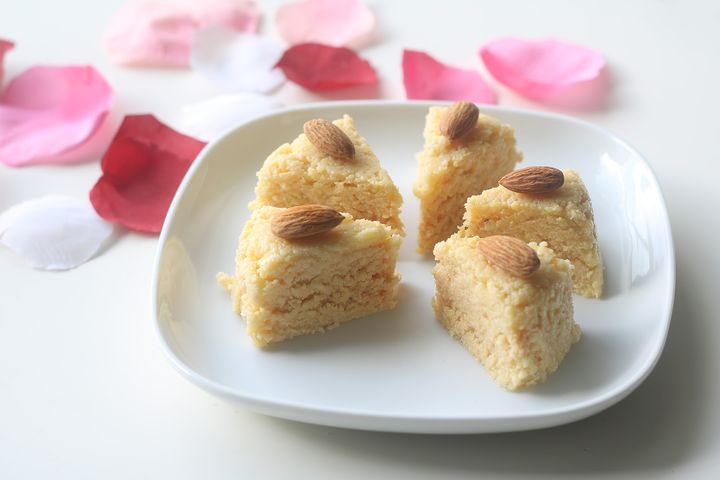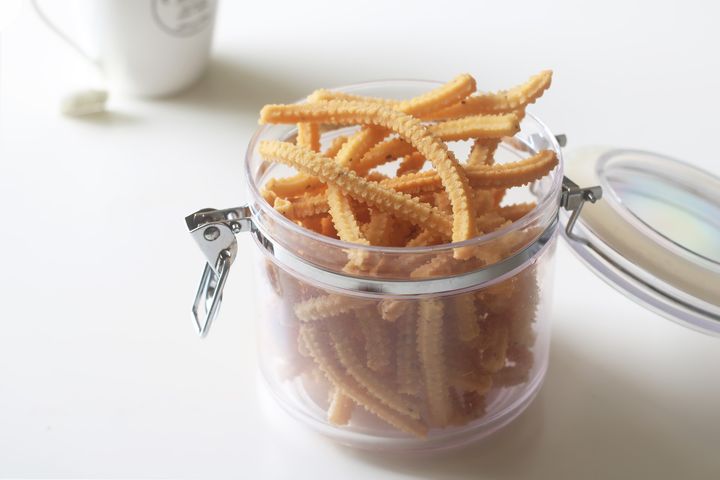Sweet Boondi
Discover the Delightful World of Sweet Boondi - A South Indian Treat to Remember!
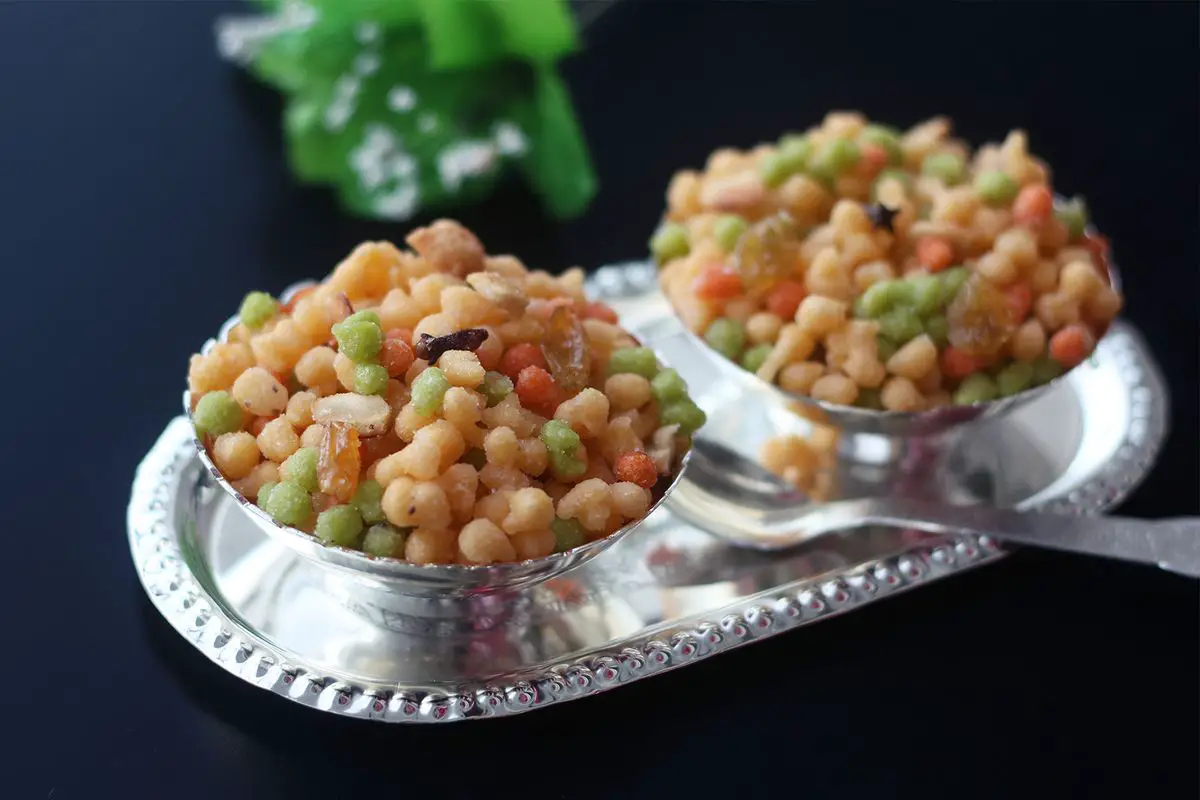
"South India has a rich culinary heritage, and Sweet Boondi is one such sweet that has been enjoyed for generations. This crunchy and delightful ball of sweetness is the base ingredient for one of India's most popular sweets - Laddus.
Imagine biting into a crunchy, sweet ball, and feeling the rush of flavors explode in your mouth. That's the magic of Sweet Boondi, and it's what makes it such a popular snack in South India.
Whether you're in the mood for something sweet and crunchy, or simply want to try something new, Sweet Boondi is a must-try. And the best part? It's incredibly easy to make, so you can enjoy it anytime you want.
So, why not serve up a batch of Sweet Boondi with hot tea and savories, and treat your family to a delightful treat that they'll never forget?
We're sure they'll love it, and you will too! So, go ahead and give this recipe a try, and share your thoughts with us in the comments below. We can't wait to hear what you think!"
What Is Sweet Boondi?
- Sweet boondi is a traditional Indian sweet dish that combines the succulent main ingredient of gram flour with a perfect blend of Indian spices and unique seasoning. The dish is made by frying gram flour pearls until they are crisp but not brown, and then coating them in a fragrant cardamom sugar syrup.
- The addition of ghee-roasted cashews, golden raisins, and aromatic cloves adds a delightful texture and flavor to this beloved sweet treat. Sweet boondi is a quintessential part of Indian celebrations and festivals, loved for its irresistible sweetness and satisfying crunch.
Why You'll Love Sweet Boondi?
- Deliciously Crunchy Texture: The sweet boondi has a delightful, crunchy texture that adds a satisfying element to your snack or dessert.
- Gluten-Free and Protein-Packed: Made from gram flour, or besan flour, sweet boondi is gluten-free and high in protein, making it a healthier option for satisfying your sweet tooth.
- Low in Calories: When prepared in the right way, sweet boondi can be a low-calorie treat, perfect for those looking to indulge in something sweet without the guilt.
- Rich in Nutrients: With the addition of cashews, raisins, and cloves, sweet boondi provides a good dose of essential nutrients and antioxidants.
- Balanced Sweetness: The sugar syrup used to coat the boondi provides just the right amount of sweetness without being overwhelming, making it a perfect sweet treat for all.
- Versatile Snack or Dessert: Enjoy sweet boondi on its own as a snack or sprinkle it over creamy desserts like ice cream and yogurt for an added crunch and sweetness.
Ingredients for Sweet Boondi
- Gram Flour (Besan): It is the main ingredient used to make the boondi batter. It provides the base flavor and texture to the sweet boondi.
- Baking Soda: Helps in making the boondi crispy and light.
- Salt: Enhances the overall flavor of the sweet boondi.
- Food Colors (Orange, Red, Green): Adds visual appeal to the sweet boondi, making it more vibrant and attractive.
- Sugar: Forms the base for the sugar syrup, giving the sweet boondi its sweet taste.
- Cardamom Powder: Adds a warm, aromatic flavor to the sugar syrup and the sweet boondi.
How To Make Sweet Boondi?
- To make sweet boondi, start by sieving gram flour in a bowl and adding salt, baking soda, food color, and water. Mix the batter until it becomes smooth, making sure it's not too thick or too thin.
- Next, heat a pan with oil over low to medium heat. Use a boondi karandi or a perforated ladle to pour the batter into the oil, frying the boondi until they are crisp but not brown.
- After frying, drain the excess oil and prepare the sugar syrup by boiling sugar and water until it reaches a single string consistency. Then add cardamom powder and mix well before adding the fried boondis into the syrup.
- Finally, heat ghee in a small pan, fry cashews, raisins, and cloves, then pour the mixture over the boondis and let it sit until the sugar syrup is completely absorbed.
The key steps of making sweet boondi include getting the batter consistency right, frying the boondi to the correct level of crispness, and ensuring the sugar syrup coats the boondis evenly. Following these steps will result in a flavorful sweet boondi experience.
Serving Suggestions
- Enjoy as a sweet snack: Sweet boondi can be enjoyed as a standalone sweet snack, perfect for satisfying your sweet tooth after a meal or as a mid-day treat.
- Pair with chai: For a traditional Indian experience, pair sweet boondi with a warm cup of chai. The combination of the sweet and crunchy boondi with the aromatic spiced tea is a delightful treat.
- Serve with yogurt: Balance out the sweetness of the boondi by serving it with a side of plain yogurt. The creamy and tangy yogurt complements the sweet boondi, creating a harmonious and delicious pairing.
- Add to desserts: Use sweet boondi as a topping for desserts like ice cream or as a mix-in for creamy kheer. The crunchy texture and sugary flavor will add an extra layer of indulgence to your favorite sweet treats.
- Include in thali meals: Sweet boondi can be included as a part of a thali meal, alongside savory dishes like dal, vegetables, and rice. Its sweet flavor provides a delightful contrast to the savory and spicy dishes in the thali.
- Gift or share with loved ones: Package sweet boondi in decorative boxes or jars and share them as a sweet and thoughtful gift for friends and family during festive occasions or celebrations.

Tips for Making Sweet Boondi
- Preparation Time: It's important to have all your ingredients measured and ready to go before you start making sweet boondi. This will help you move quickly through the process.
- Cooking Techniques: When frying the boondi, make sure to fry them until they are just crisp but not brown. This will ensure that they are cooked through but still retain their round shape.
- Garnishing: The final step of adding the ghee mixture and letting the boondi sit is essential for allowing the sugar syrup to fully crystallize. This will give the boondi a beautiful, sparkly appearance.
- Consistency of Sugar Syrup: It's important to achieve the single string consistency when making the sugar syrup. This will ensure that the boondis are well coated and have the perfect level of sweetness.
- Adjusting Batter Thickness: If you find that your boondis are not round, adjust the batter thickness as needed. Add a little water if it's too thick or a little more flour if it's too thin.
- Optional Coloring: If you choose to add food coloring, make sure to mix the colors separately with small batches of batter. This will ensure an even and vibrant look to the sweet boondi.
Variations for Sweet Boondi
- Nutty Twist: Add chopped almonds, pistachios, or any other nuts of your choice to the boondi for an extra crunch and nutty flavor.
- Fruity Flavors: Mix in some dried fruits like chopped dried mango, pineapple, or cranberries to bring a fruity twist to the traditional sweet boondi.
- Spiced Up Boondi: For a unique twist, add a pinch of ground cinnamon or nutmeg to the sugar syrup for a warm and spicy flavor.
- Chocolate Infusion: Drizzle melted chocolate over the boondi for a decadent twist, or mix cocoa powder into the batter for a chocolatey flavor.
- Citrus Zest: Add a hint of citrus by mixing in some lemon or orange zest to the batter for a refreshing and tangy twist.
- Seasonal Variations: Experiment with different seasonal flavors like pumpkin spice, peppermint, or gingerbread spices for a festive twist to your sweet boondi.
How to Store Sweet Boondi
- Proper Storage Tips: To maintain the freshness of sweet boondi, store it in an airtight container at room temperature. This will prevent the boondi from getting soggy or losing its texture.
- Key Ingredient Care: For the key ingredients like cashews, raisins, and cloves, store them separately in airtight containers in a cool, dry place. This will help preserve their flavor and texture for a longer period.
- Avoid Moisture: Ensure that the storage containers are moisture-free to prevent the sweet boondi from becoming sticky. You can also add a small piece of paper towel in the container to absorb any excess moisture.
- Use Within a Week: Sweet boondi is best enjoyed within a week of making it. Be mindful of the expiry date of the ingredients used and try to consume it before that for the best taste.
- Refrigeration Caution: Avoid refrigerating the sweet boondi as it can cause it to become excessively hard. Room temperature storage is ideal for maintaining its delicious taste and texture.
- Enjoy Freshness: By following these storage tips, you can ensure that your sweet boondi remains fresh and delicious for as long as possible. Store it well and savor the homemade goodness whenever you crave a sweet treat!
Frequently Asked Questions (FAQs)
Why is the batter consistency important for making sweet boondi?
- The batter consistency is crucial for making round boondi. If the batter is too thick, the boondis will have a tail, and if it's too thin, they will be flat. Adjust the consistency by adding or reducing water as required.
Can I skip adding food colors to the sweet boondi?
- Yes, adding food colors is optional. If you prefer not to use them, you can simply repeat the process with the remaining batter without adding any colors.
How do I know when the sugar syrup has reached the right consistency?
- The sugar syrup should reach a single string consistency. To test this, lift a spoon from the syrup, and the last drop falling from it should form a single string-like consistency.
Can I make sweet boondi ahead of time?
- Yes, you can make sweet boondi ahead of time. Let it sit for 1/2 to 1 hour or until the sugar syrup is completely absorbed by the boondis and the sugar in the syrup is crystallized.
What if I don't have a boondi karandi or a perforated ladle?
- If you don't have a boondi karandi or a perforated ladle, you can use a regular spoon to pour the batter into the oil. It may not give perfect round boondis, but it will still work.
Can I use any other nuts in place of cashews and raisins for the ghee mixture?
- Yes, you can use any nuts of your choice in place of cashews and raisins for the ghee mixture. Almonds, pistachios, or any other nuts can be used as a substitute.
Recipe Card
Sweet Boondi 2020-01-14 02:04:54

Sweet Boondi
Serves 6
Prep Time: 00:01
Cook Time: 00:20
Total Time: 00:30
Ingredients
- 1 cup Gram Flour/Besan Flour/Kadalai Mavu
- 1/8 tsp Baking Soda
- a pinch of Salt
- a pinch of Orange, Red and Green Food Colours
- 1/2 cup water or as needed
- Oil for deep frying
- 3/4 cup Sugar
- 1/2 cup Water
- 1/2 tsp Cardamom Powder
- 1 tbsp Ghee
- 10, broken into small pieces Cashews
- 15 Raisins
- 4 Cloves
Instructions
- Sieve gram flour in a bowl. Then add salt, baking soda, food color and water, mix it well until the batter becomes smooth. The batter should be little thick.
- (Notes: Make the batter perfectly then only you will get round boondi. If the batter is too thick, then you will get boondis with a tail, so add one tbsp of water to the batter and try again. If the batter is too thin, then you will get flat boondis, so add a tbsp of batter and mix well.)
- Meanwhile, heat a wide pan with enough oil over low to medium heat.
- When the oil heats, hold a boondi karandi or a perforated ladle (ladle with holes) over the oil.
- Then pour a ladleful of batter over the ladle and gently tap the ladle or spread it out to let the batter fall drop by drop into the oil.
- Fry the boondi till they are little crisp but not brown and when the sizzling sound of the oil begins to quiet down.
- Take out the boondi on a clean kitchen towel to drain off the excess oil.
- Then wipe off the ladle with a cloth for each batch.
- Take two ladle batter for red and green colour in two separate small bowls.
- Mix green and red colours separately. This is an optional step, only if you are adding food colours. Otherwise, repeat the process with the rest of the batter.
- Take sugar and water in a pan, mix well and bring it to boil until you get a single string consistency.
- When you take the spoon from the syrup and see, the last drop falling from the syrup form a single string like consistency. Add in cardamom powder, mix well. Switch off the heat.
- Then add the fried boondis into the syrup. Gently toss them and mix till boondis are well coated in sugar syrup.
- Finally, heat a small pan with ghee.
- When the ghee melts, add cashews, fry till they become golden brown, then add raisins, fry until puffed and add in cloves and fry until spluttering.
- Pour this ghee mixture over the boondis, mix well until combined.
- Let this sit for 1/2 to 1 hour or until the sugar syrup is completely absorbed by boondis and the sugar in the syrup is crystallized.
By Santhi Therese
The Indian Claypot
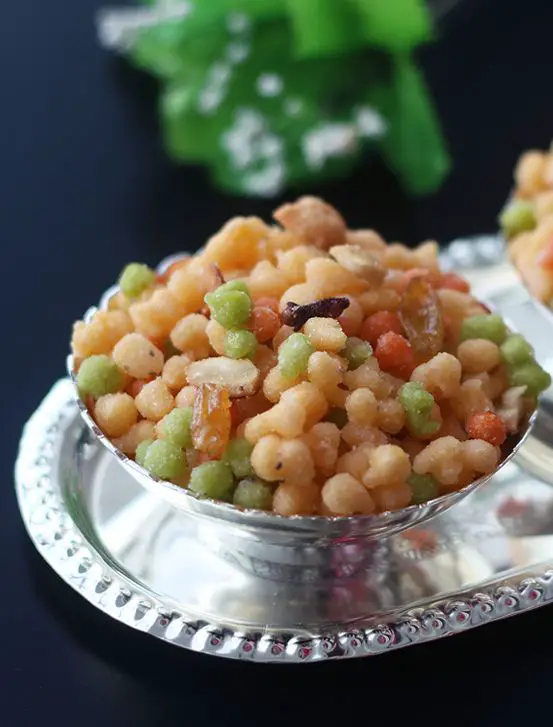
Step-By-Step Instructions:
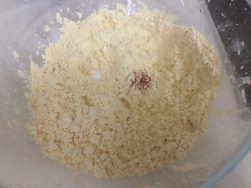
Sieve gram flour in a bowl. Then add salt, baking soda, food color
and water,
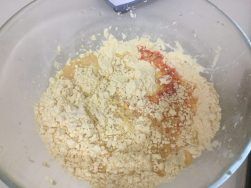
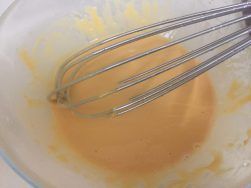
mix it well until the batter becomes smooth.
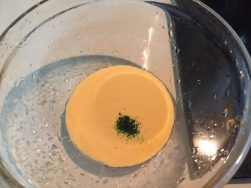
Take two ladle batter for red and green colour in two separate small bowls.
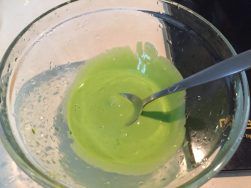
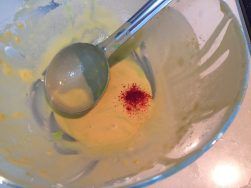
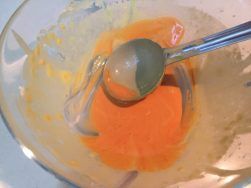
Mix green and red colours separately.
Meanwhile, heat a wide pan with enough oil over low to medium heat. Then the oil heats, hold a boondi karandi or a perforated ladle (ladle with holes) over the oil. Then pour a ladleful of batter over the ladle and gently tap the ladle or spread it out to let the batter fall drop by drop into the oil.
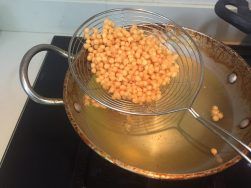
Fry the boondi till they are little crisp but not brown and when the sizzling
sound of the oil begins to quiet down.
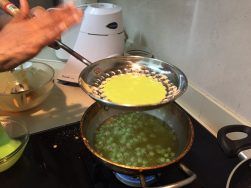
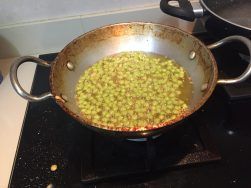
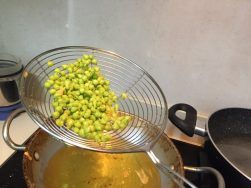
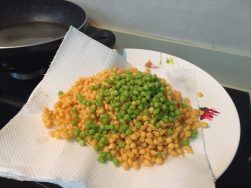
Take out the boondi on a clean kitchen towel to drain off the excess oil.
Then wipe off the ladle with a cloth for each batch.
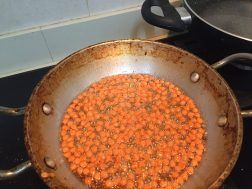
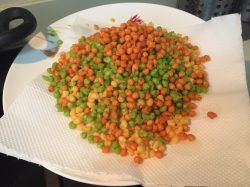
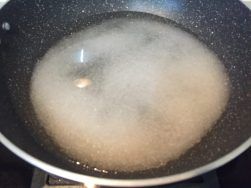
Take sugar and water in a pan, mix well and bring it to boil until you get a
single string consistency.
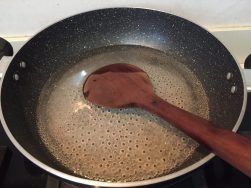
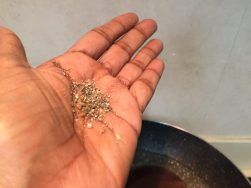
Add in cardamom powder, mix well. Switch off the heat.
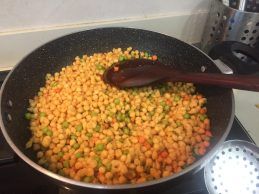
Then add the fried boondis into the syrup. Gently toss them and mix till boondis are well coated in sugar syrup.
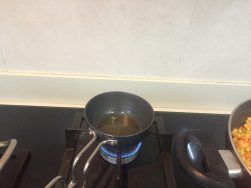
Finally, heat a small pan with ghee.
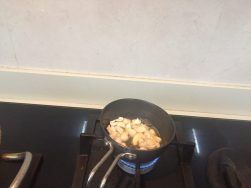
When the ghee melts, add cashews,
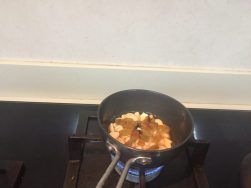
fry till they become golden brown, then add raisins, fry until puffed and
add in cloves and fry until spluttering.
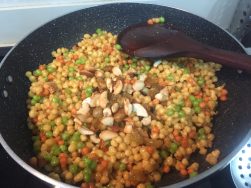
Pour this ghee mixture over the boondis, mix well until combined.
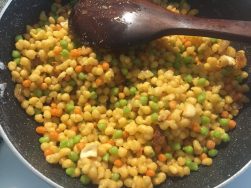
Let this sit for 1/2 to 1 hour or until the sugar syrup is completely absorbed
by boondis and the sugar in the syrup is crystallized.

